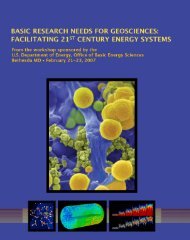Measurement Science Roadmap for Net-Zero Energy Buildings
Measurement Science Roadmap for Net-Zero Energy Buildings
Measurement Science Roadmap for Net-Zero Energy Buildings
- No tags were found...
Create successful ePaper yourself
Turn your PDF publications into a flip-book with our unique Google optimized e-Paper software.
Table IV‐2. Intelligent <strong>Buildings</strong> – <strong>Measurement</strong> Barriers and Challenges(● = one vote)Models and Simulation (continued)HighPriorityMediumPriority– How to measure energy savings (kwh, kw, quads) and relate that to cost of energy(e.g., diverse sources⎯hydro, natural gas, coal)– Time‐consuming aspects of collecting and monitoring data• Simulation tools are lacking and/or existing tools require custom configuration ●●●●• Focus of current Building In<strong>for</strong>mation Models (BIMs) on design rather thanoperations and facility maintenance ●●●LowerPriority• Lack of interpretive tools that convert data into in<strong>for</strong>mation useful <strong>for</strong> buildingoperators and consumers (i.e., actionable in<strong>for</strong>mation)• Uncertain model validation methods and range of predictive capability (% accuracy)Intelligent System Per<strong>for</strong>manceHighPriority• Lack of tools to automate labor‐intensive commissioning practices ●●●●●●●●●●– Lack of intelligent techniques applied to building operation problems, fromwhole buildings to individual components• Inadequate/unavailable test beds and methods of test <strong>for</strong> evaluation of technologycontrols and Fault Detection and Diagnosis (FDD) ●●●●●●●●●– Virtual test beds (e.g., to simulate abnormal conditions)– In situ evaluation of test bed results under various conditions– Per<strong>for</strong>mance benchmarks <strong>for</strong> comparing control strategies (e.g., more complexthan just energy consumption)– Building system per<strong>for</strong>mance metrics beyond “net‐zero energy”– System level test beds (e.g., Virtual Cybernetic Building Testbed (VCBT)) to testnew monitoring and control systems– Test beds to evaluate flow sensing technology (e.g., air, water, etc.)• Insufficient best practice guidelines <strong>for</strong> “intelligent” system design, operation andmaintenance, including ●●●●●●●●– Demonstrating value of added cost to obtain data– Lack of reliable data on cost‐effectiveness of measures and designs <strong>for</strong> specificclimate zones/regions– Ability to integrate available <strong>for</strong>ecasted weather data and responsiveness toactual or anticipated conditionsMediumPriorityLowerPriority• Dependence on external factors, such as the grid; and challenges associated withtime dependence of energy use, power factors ●●●• Limited ability to determine measurement quality (e.g., via virtual sensor) ●• Lack of codes and rein<strong>for</strong>cement to calibrate/maintain sensors• Limited capability to effectively use wireless technology to collect usefulin<strong>for</strong>mation• Challenges with addressing existing (not new) building stock• Lack of capabilities to develop and implement reliability measures• Lack of smart components that communicate status/per<strong>for</strong>mance reliability, cost,and needs28 <strong>Measurement</strong> <strong>Science</strong> <strong>for</strong> <strong>Net</strong>-<strong>Zero</strong> <strong>Energy</strong> <strong>Buildings</strong>
















